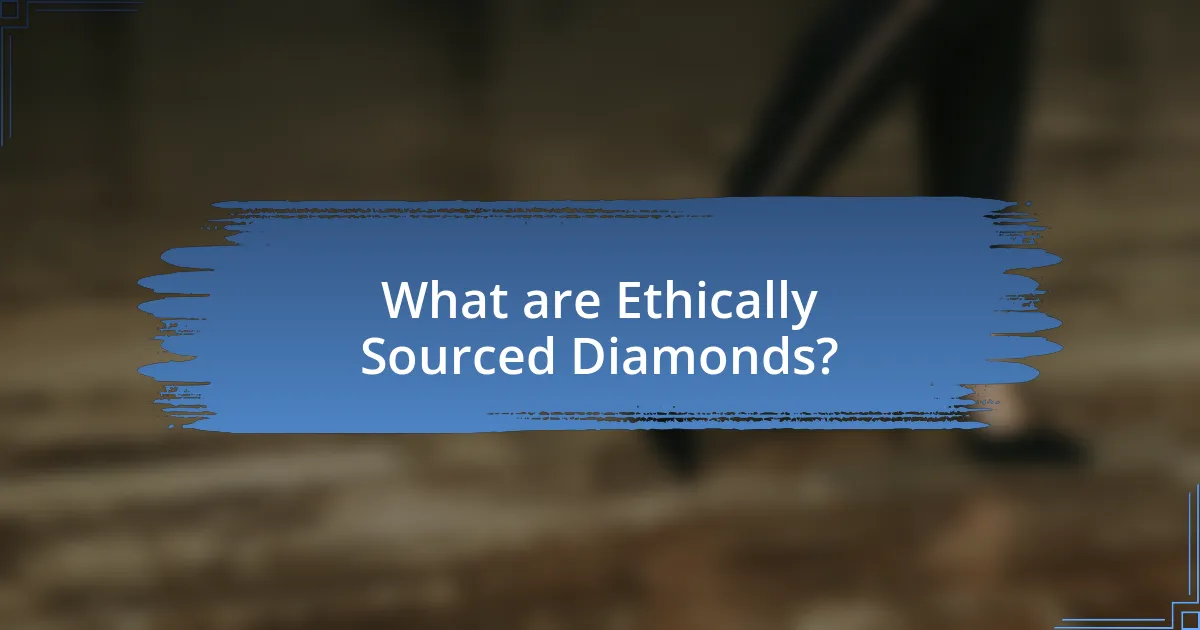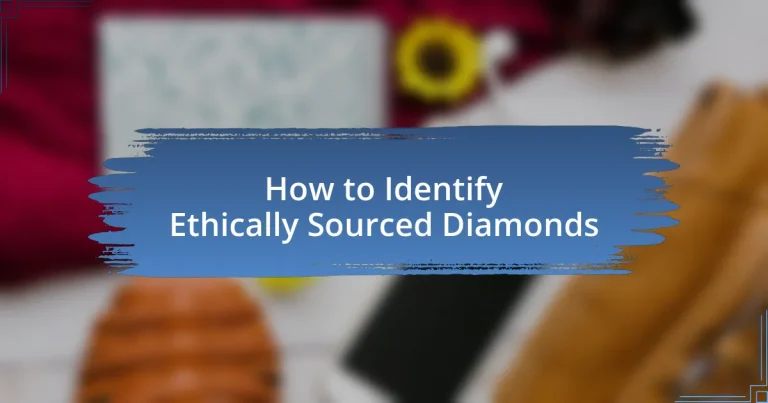Ethically sourced diamonds are defined as those mined and produced in compliance with ethical standards that respect human rights and minimize environmental impact. This article outlines the criteria for classifying diamonds as ethically sourced, including adherence to the Kimberley Process and transparency in the supply chain. It highlights the differences between ethically sourced and traditional diamonds, emphasizing the importance of sourcing for ethical considerations. Additionally, the article provides guidance on how consumers can identify ethically sourced diamonds, the certifications to look for, and the questions to ask jewelers to ensure responsible purchasing practices.

What are Ethically Sourced Diamonds?
Ethically sourced diamonds are diamonds that are mined and produced in a manner that adheres to ethical standards, ensuring that the rights of workers and local communities are respected and that environmental impacts are minimized. These diamonds are often certified by organizations that verify their origin and the conditions under which they were mined, such as the Kimberley Process, which aims to prevent the trade of conflict diamonds. Additionally, ethically sourced diamonds may also include lab-grown diamonds, which are created in controlled environments and do not involve mining, thus eliminating many ethical concerns associated with traditional diamond mining.
How do we define ethically sourced diamonds?
Ethically sourced diamonds are defined as diamonds that are mined and traded in a manner that respects human rights, environmental sustainability, and fair labor practices. This definition is supported by initiatives such as the Kimberley Process, which aims to prevent the trade of conflict diamonds, and various certification programs that ensure transparency in the supply chain. These diamonds are often sourced from mines that adhere to strict ethical standards, ensuring that the workers are treated fairly and that the mining practices do not harm the environment.
What criteria classify a diamond as ethically sourced?
A diamond is classified as ethically sourced based on criteria that ensure it is mined and traded in a manner that respects human rights and environmental standards. Key criteria include adherence to the Kimberley Process, which aims to prevent the trade of conflict diamonds, and compliance with labor laws that guarantee fair wages and safe working conditions for miners. Additionally, ethical sourcing involves transparency in the supply chain, where the origin of the diamond is traceable, and the environmental impact of mining practices is minimized. These standards are supported by organizations such as the Responsible Jewelry Council, which certifies companies that meet ethical sourcing guidelines.
Why is the source of diamonds important for ethical considerations?
The source of diamonds is crucial for ethical considerations because it determines whether the diamonds are conflict-free and sourced from responsible mining practices. Diamonds mined in conflict zones often finance violence and human rights abuses, as evidenced by the Kimberley Process, which was established to prevent the trade of conflict diamonds. Furthermore, ethical sourcing ensures that labor practices are fair and environmentally sustainable, addressing concerns about exploitation and ecological damage. Thus, understanding the source of diamonds directly impacts the ethical implications of their production and trade.
What are the differences between ethically sourced and traditional diamonds?
Ethically sourced diamonds are obtained through practices that ensure fair labor, environmental sustainability, and community benefits, while traditional diamonds may be mined under conditions that can involve human rights abuses and environmental degradation. Ethically sourced diamonds often come with certifications from organizations like the Kimberley Process, which aims to prevent conflict diamonds from entering the market, whereas traditional diamonds may not have such guarantees. Furthermore, ethically sourced diamonds can include lab-grown options, which have a lower environmental impact compared to traditional mining methods that can cause significant ecological harm.
How do the mining processes differ?
Mining processes differ primarily in their methods of extraction and environmental impact. For instance, alluvial mining involves extracting diamonds from riverbeds or ocean floors, which typically has a lower environmental footprint compared to open-pit mining, where large amounts of earth are removed to access diamond deposits. Open-pit mining can lead to significant habitat destruction and soil erosion. Additionally, underground mining, which involves creating tunnels to reach deeper deposits, presents different challenges such as safety risks and higher operational costs. Each method’s efficiency and sustainability vary, influencing the ethical considerations surrounding diamond sourcing.
What impact do these differences have on communities and the environment?
The differences in diamond sourcing significantly impact communities and the environment by influencing economic stability and ecological health. Ethically sourced diamonds often support local economies through fair wages and community development initiatives, whereas diamonds from unethical sources can perpetuate poverty and conflict. For instance, the Kimberley Process Certification Scheme aims to prevent the trade of conflict diamonds, promoting responsible mining practices that protect both workers and ecosystems. Additionally, ethical sourcing reduces environmental degradation by encouraging sustainable mining techniques, which minimize habitat destruction and pollution. This contrast highlights the importance of choosing ethically sourced diamonds for fostering positive community outcomes and preserving environmental integrity.
Why should consumers care about ethically sourced diamonds?
Consumers should care about ethically sourced diamonds because they ensure that the diamonds are mined without contributing to human rights abuses or environmental degradation. Ethically sourced diamonds are often certified by organizations that verify their origin and the conditions under which they were mined, such as the Kimberley Process, which aims to prevent the trade of conflict diamonds. This certification provides consumers with the assurance that their purchase supports fair labor practices and sustainable mining methods, thereby promoting social responsibility and environmental stewardship.
What ethical concerns are associated with traditional diamond sourcing?
Traditional diamond sourcing raises significant ethical concerns, primarily related to human rights abuses, environmental degradation, and the funding of conflict. Human rights abuses include child labor and exploitation of workers in mines, particularly in countries like the Democratic Republic of Congo, where reports indicate that children as young as seven are involved in dangerous mining activities. Environmental degradation occurs due to the destructive mining practices that lead to habitat destruction and pollution of local water sources. Additionally, diamonds sourced from conflict zones, often referred to as “blood diamonds,” have been linked to financing armed groups that perpetuate violence and instability, as highlighted by the United Nations in various reports. These concerns underscore the need for transparency and ethical practices in the diamond industry.
How does purchasing ethically sourced diamonds contribute to positive change?
Purchasing ethically sourced diamonds contributes to positive change by supporting fair labor practices and sustainable mining methods. Ethically sourced diamonds are obtained from suppliers who adhere to strict guidelines that ensure workers receive fair wages and work in safe conditions, reducing exploitation and human rights abuses. For instance, the Kimberley Process Certification Scheme aims to prevent the trade of conflict diamonds, promoting transparency in the diamond supply chain. Additionally, these diamonds often come from mines that prioritize environmental sustainability, minimizing ecological damage and promoting responsible land use. This approach not only benefits local communities economically but also fosters a more ethical and responsible jewelry industry.

How can you identify ethically sourced diamonds?
To identify ethically sourced diamonds, verify their certification from recognized organizations such as the Kimberley Process or the Responsible Jewellery Council. These certifications ensure that the diamonds are conflict-free and sourced from mines that adhere to ethical labor practices. Additionally, inquire about the diamond’s origin and request documentation that traces its supply chain, confirming that it was mined and traded responsibly.
What certifications should you look for in ethically sourced diamonds?
When seeking ethically sourced diamonds, look for certifications such as the Kimberley Process Certification Scheme (KPCS), which ensures that diamonds are conflict-free and sourced from legitimate mines. Additionally, certifications from organizations like the Responsible Jewellery Council (RJC) and the Fair Trade Gold standard provide assurance that diamonds are mined and traded under ethical conditions, promoting fair labor practices and environmental sustainability. These certifications are crucial as they verify the ethical sourcing of diamonds, ensuring compliance with established standards in the diamond industry.
What organizations provide certification for ethical sourcing?
Organizations that provide certification for ethical sourcing include the Responsible Jewelry Council (RJC), Fair Trade International, and the Kimberley Process Certification Scheme (KPCS). The Responsible Jewelry Council certifies companies that adhere to ethical, social, and environmental standards in the jewelry supply chain. Fair Trade International focuses on ensuring fair wages and working conditions for producers, while the Kimberley Process Certification Scheme aims to prevent the trade of conflict diamonds by requiring certification for diamonds sourced from member countries. These organizations establish guidelines and standards that help consumers identify ethically sourced diamonds.
How can you verify the authenticity of these certifications?
To verify the authenticity of certifications for ethically sourced diamonds, check for the issuing authority’s credibility and the certification’s unique identification number. Reputable organizations, such as the Gemological Institute of America (GIA) or the International Gemological Institute (IGI), provide certifications that can be cross-referenced on their official websites. These organizations maintain databases where you can input the certification number to confirm its validity and details about the diamond, including its origin and grading. This process ensures that the certification is legitimate and that the diamond adheres to ethical sourcing standards.
What questions should you ask your jeweler about diamond sourcing?
To ensure diamonds are ethically sourced, ask your jeweler the following questions: “Where do your diamonds come from?” This question helps identify the origin of the diamonds and whether they are conflict-free. Additionally, inquire, “Do you have certifications for your diamonds?” Certifications from organizations like the Kimberley Process can verify ethical sourcing. Another important question is, “What are your policies on sourcing and labor practices?” This will provide insight into the jeweler’s commitment to ethical labor standards. Lastly, ask, “Can you provide information on the supply chain?” Understanding the supply chain can reveal transparency and ethical practices in sourcing.
How can you assess the jeweler’s commitment to ethical practices?
To assess a jeweler’s commitment to ethical practices, examine their certifications and sourcing policies. Reputable jewelers often hold certifications from organizations such as the Responsible Jewellery Council or adhere to the Kimberley Process, which aims to prevent conflict diamonds from entering the market. Additionally, inquire about their supply chain transparency, including where their diamonds are sourced and whether they provide information on the mining conditions. A commitment to ethical practices is also reflected in their support for fair labor practices and environmental sustainability initiatives.
What information should be provided about the diamond’s origin?
The information that should be provided about the diamond’s origin includes the country of origin, the mining practices used, and whether the diamond is conflict-free. The country of origin indicates where the diamond was mined, which can affect its ethical sourcing. Mining practices should detail whether they adhere to environmental and labor standards, ensuring responsible extraction. Additionally, confirming that the diamond is conflict-free assures consumers that it was not sourced from areas where mining funds violence or human rights abuses. These details are essential for consumers seeking to identify ethically sourced diamonds.

What are the best practices for purchasing ethically sourced diamonds?
To purchase ethically sourced diamonds, consumers should prioritize buying from retailers who provide certification from recognized organizations, such as the Kimberley Process, which ensures that diamonds are conflict-free. Additionally, consumers should seek out brands that are transparent about their sourcing practices and provide information on the origin of their diamonds. Research indicates that approximately 61% of consumers are willing to pay more for ethically sourced products, highlighting the demand for transparency in the diamond industry. Furthermore, supporting companies that engage in fair labor practices and environmental sustainability can enhance the ethical aspect of the purchase.
How can you ensure your diamond purchase supports ethical practices?
To ensure your diamond purchase supports ethical practices, buy diamonds that are certified by reputable organizations such as the Kimberley Process, which aims to prevent the trade of conflict diamonds. Additionally, seek out brands that provide transparency in their sourcing, including information about the mine of origin and the labor practices involved. Research shows that diamonds from responsible sources often come with certifications like Fair Trade or those from companies committed to sustainable mining practices, which can be verified through their corporate social responsibility reports.
What are the key factors to consider when choosing a jeweler?
When choosing a jeweler, key factors include reputation, certification, and ethical sourcing practices. A jeweler’s reputation can be assessed through customer reviews and industry ratings, which indicate trustworthiness and quality of service. Certification from recognized organizations, such as the Gemological Institute of America (GIA), ensures that the jeweler adheres to industry standards for quality and authenticity. Additionally, ethical sourcing practices are crucial; jewelers should provide transparency regarding the origins of their diamonds, confirming that they are conflict-free and sourced responsibly. This information can often be verified through documentation or third-party certifications, reinforcing the jeweler’s commitment to ethical practices.
How can you research a diamond’s sourcing history effectively?
To research a diamond’s sourcing history effectively, obtain the diamond’s grading report from a reputable gemological laboratory, such as the Gemological Institute of America (GIA) or the International Gemological Institute (IGI). These reports often include information about the diamond’s origin and any certifications regarding ethical sourcing. Additionally, inquire about the diamond’s provenance from the retailer, as many ethical jewelers provide transparency regarding their supply chains. According to the Kimberley Process, which aims to prevent conflict diamonds from entering the market, diamonds should come with certification that traces their origin. This certification can serve as proof of ethical sourcing.
What tips can help you make informed decisions when buying ethically sourced diamonds?
To make informed decisions when buying ethically sourced diamonds, prioritize purchasing from certified retailers who provide transparency about their sourcing practices. Look for certifications such as the Kimberley Process, which aims to prevent conflict diamonds from entering the market, and ensure the retailer can trace the diamond’s origin. Additionally, inquire about the environmental and social impact of the mining process, as responsible companies often disclose their efforts in sustainability and community support. Researching the retailer’s reputation through reviews and industry ratings can further validate their commitment to ethical sourcing.
How can you compare different diamonds based on ethical sourcing criteria?
To compare different diamonds based on ethical sourcing criteria, evaluate their certifications, supply chain transparency, and adherence to ethical mining practices. Certifications such as the Kimberley Process Certification Scheme ensure that diamonds are conflict-free, while organizations like the Responsible Jewellery Council provide standards for ethical sourcing. Additionally, assess the transparency of the supply chain by examining whether the diamond’s origin is disclosed and if the mining practices align with environmental and social responsibility standards. Research indicates that diamonds sourced from mines with fair labor practices and minimal environmental impact are more ethically sound, reinforcing the importance of these criteria in making informed comparisons.
What resources are available for consumers interested in ethical diamonds?
Consumers interested in ethical diamonds can access various resources, including certification organizations, educational websites, and ethical jewelry retailers. Certification organizations like the Responsible Jewellery Council and the Kimberley Process provide guidelines and standards for ethical sourcing. Educational websites such as Ethical Metalsmiths and the Diamond Development Initiative offer insights into the impact of diamond mining and ethical practices. Additionally, retailers like Brilliant Earth and MiaDonna specialize in ethically sourced diamonds, ensuring transparency in their supply chains. These resources collectively empower consumers to make informed decisions regarding ethical diamond purchases.


